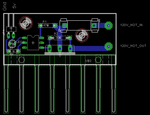jdraughn
Junior Member level 1
I want to heat nichrome wire to build a little SMD oven and control it using a triac controlled with a microcontroller using PID.
I scoured the internet looking for triac examples and they all varied. Can someone please check over my schematic and parts layout for any glaring errors?
I tested the schematic on a breadboard using a transformer that output 13v AC (400mA) that slowly warmed up my 44 ohm length of nichrome wire (after wrapping it in paper to to contain the heat since I was passing such a tiny amount of current).
It did get slightly warm after 5 minutes, and now I would like to mount the setup on a PCB, and use maybe a 60v transformer to test again before running a full 120v.
I am mostly concerned with the resistor values (they all varied on the internet), and if my board layout will work ok. Also, I don't believe I need a snubber because I am just heating nichrome wire, however I wonder if it would hurt to add one just in case the nichrome wire ends up in some kind mild coil shape which could cause inductance issues?
Thanks


I scoured the internet looking for triac examples and they all varied. Can someone please check over my schematic and parts layout for any glaring errors?
I tested the schematic on a breadboard using a transformer that output 13v AC (400mA) that slowly warmed up my 44 ohm length of nichrome wire (after wrapping it in paper to to contain the heat since I was passing such a tiny amount of current).
It did get slightly warm after 5 minutes, and now I would like to mount the setup on a PCB, and use maybe a 60v transformer to test again before running a full 120v.
I am mostly concerned with the resistor values (they all varied on the internet), and if my board layout will work ok. Also, I don't believe I need a snubber because I am just heating nichrome wire, however I wonder if it would hurt to add one just in case the nichrome wire ends up in some kind mild coil shape which could cause inductance issues?
Thanks
